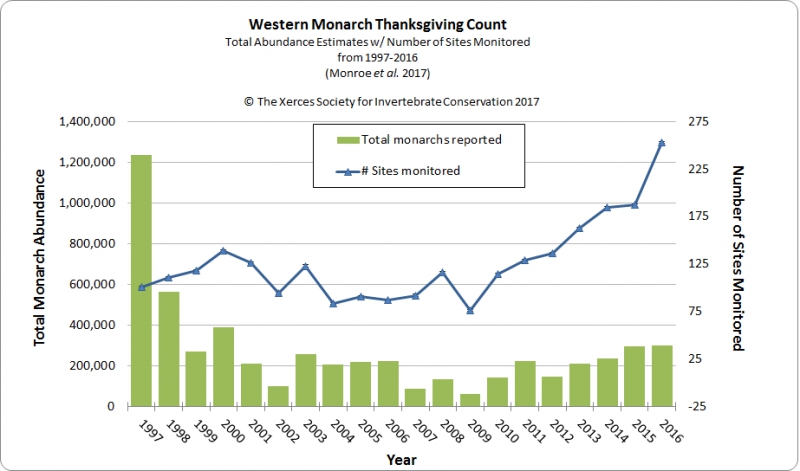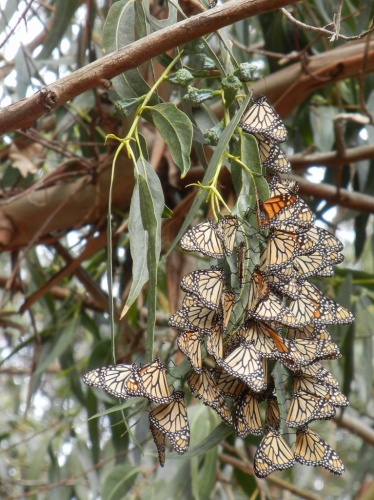From the Open-Publishing Calendar
From the Open-Publishing Newswire
Indybay Feature
Number of Monarchs Overwintering in California Remains Low
Western Monarch Thanksgiving Count results show that key sites had fewer butterflies than last year
PORTLAND, Ore., February 8, 2017—A survey of monarch butterflies overwintering in California shows that the population has not rebounded. Although the total number of monarchs counted this year was greater than last, the difference is due to a large increase in volunteer effort. Counts at major sites were down when compared to recent years.
Volunteers with the Xerces Society’s Western Monarch Thanksgiving Count visited 253 sites and tallied a total of 298,464 monarchs—a fraction of the 1.2 million monarchs recorded in the late 1990s. Key sites such as Pismo Beach and Natural Bridges saw lower populations this year, and all but one of the 15 sites which have been continuously monitored since 1997 had lower counts than in the prior year.
There are a few positive findings from this year’s results. Four new sites were documented in Southern California and a private site in Monterey County hosted over 39,000 butterflies—the largest aggregation observed in the last 10 years on the California coast.
Monarchs from as far away as Idaho, Utah and Arizona converge to spend the winter in tree groves along the Pacific coast from Mendocino County, California, to northern Baja, Mexico. This gathering of monarchs provides a unique opportunity to gauge the health of the monarch population from the western United States.
Data gathered each year by WMTC participants was recently used in an analysis which documented a 74% decline in California overwintering population since the late 1990s—mirroring the steep decline observed at the monarch overwintering sites in the state of Michoacán, Mexico and where a subset of western monarchs migrate to.
This year marks the 20th anniversary of the Western Monarch Thanksgiving Count, the longest running and most comprehensive effort to monitor overwintering monarchs in California. The count happens during a three-week period centered on Thanksgiving. Biologists, land managers, and citizen scientists visit overwintering sites year after year to monitor the butterflies. Volunteer participation continues to grow and this year, over 100 volunteers monitored a record 253 sites, the single greatest effort since the count began in 1997. This big uptick in effort is also the results of a major effort in Santa Barbara County being led by WMTC regional coordinators Jessica Griffiths & Charis van der Heide and researchers Prof. Francis Villablanca of Cal Poly and Dan Meade who are revisiting a similar survey completed by Meade in the 1990s.
This count would not be possible without volunteers and dedicated regional coordinators including Mia Monroe, one of the count’s founders who has been the heart of the project for two decades. Mia has spent countless hours organizing, training and inspiring others.
“Showing up to participate in studies like the Thanksgiving count connects us to a bigger body of conservation work, and lets us know we can make a difference,” said Mia Monroe. “For me, getting out to count and encouraging others to do the same has been very worthwhile. I take pride in seeing how the count helps with monarch research and advocacy.”
“This extraordinary volunteer effort has recorded more monarchs in California this year than last,” said Sarina Jepsen, Endangered Species program director. “However, monarch butterfly populations are far from recovered. We will still need a focused effort to address the many threats that monarchs face—from pesticide use and habitat loss to climate change and disease.”
Citation for graph & data:
Monroe, M., E. Pelton, S. McKnight, C. Fallon, D. Frey, and S. Stevens. 2017. Western Monarch Thanksgiving Count Data from 1997–2016. Available at: http://www.westernmonarchcount.org
For More Information
The data from and information about the Western Monarch Thanksgiving Count is at http://www.westernmonarchcount.org
Read more about Xerces’ Monarch Conservation Campaign, including efforts to conserve overwintering sites in California and restore breeding habitat in key regions of the United States at http://www.xerces.org/monarchs/.
Learn about efforts to conserve western monarchs by visiting the Monarch Joint Venture website: http://monarchjointventure.org/our-work/list/category/western-monarchs
The Xerces Society for Invertebrate Conservation
Protecting the Life that Sustains Us
The Xerces Society is a nonprofit organization that protects wildlife through the conservation of invertebrates and their habitat. Since 1971, the Society has been at the forefront of invertebrate protection, harnessing the knowledge of scientists and the enthusiasm of citizens to implement conservation programs worldwide. To learn more about our work or to donate to the Society, please visit http://www.xerces.org.
http://www.xerces.org/2017/02/07/number-of-monarchs-overwintering-in-california-remains-low/
Volunteers with the Xerces Society’s Western Monarch Thanksgiving Count visited 253 sites and tallied a total of 298,464 monarchs—a fraction of the 1.2 million monarchs recorded in the late 1990s. Key sites such as Pismo Beach and Natural Bridges saw lower populations this year, and all but one of the 15 sites which have been continuously monitored since 1997 had lower counts than in the prior year.
There are a few positive findings from this year’s results. Four new sites were documented in Southern California and a private site in Monterey County hosted over 39,000 butterflies—the largest aggregation observed in the last 10 years on the California coast.
Monarchs from as far away as Idaho, Utah and Arizona converge to spend the winter in tree groves along the Pacific coast from Mendocino County, California, to northern Baja, Mexico. This gathering of monarchs provides a unique opportunity to gauge the health of the monarch population from the western United States.
Data gathered each year by WMTC participants was recently used in an analysis which documented a 74% decline in California overwintering population since the late 1990s—mirroring the steep decline observed at the monarch overwintering sites in the state of Michoacán, Mexico and where a subset of western monarchs migrate to.
This year marks the 20th anniversary of the Western Monarch Thanksgiving Count, the longest running and most comprehensive effort to monitor overwintering monarchs in California. The count happens during a three-week period centered on Thanksgiving. Biologists, land managers, and citizen scientists visit overwintering sites year after year to monitor the butterflies. Volunteer participation continues to grow and this year, over 100 volunteers monitored a record 253 sites, the single greatest effort since the count began in 1997. This big uptick in effort is also the results of a major effort in Santa Barbara County being led by WMTC regional coordinators Jessica Griffiths & Charis van der Heide and researchers Prof. Francis Villablanca of Cal Poly and Dan Meade who are revisiting a similar survey completed by Meade in the 1990s.
This count would not be possible without volunteers and dedicated regional coordinators including Mia Monroe, one of the count’s founders who has been the heart of the project for two decades. Mia has spent countless hours organizing, training and inspiring others.
“Showing up to participate in studies like the Thanksgiving count connects us to a bigger body of conservation work, and lets us know we can make a difference,” said Mia Monroe. “For me, getting out to count and encouraging others to do the same has been very worthwhile. I take pride in seeing how the count helps with monarch research and advocacy.”
“This extraordinary volunteer effort has recorded more monarchs in California this year than last,” said Sarina Jepsen, Endangered Species program director. “However, monarch butterfly populations are far from recovered. We will still need a focused effort to address the many threats that monarchs face—from pesticide use and habitat loss to climate change and disease.”
Citation for graph & data:
Monroe, M., E. Pelton, S. McKnight, C. Fallon, D. Frey, and S. Stevens. 2017. Western Monarch Thanksgiving Count Data from 1997–2016. Available at: http://www.westernmonarchcount.org
For More Information
The data from and information about the Western Monarch Thanksgiving Count is at http://www.westernmonarchcount.org
Read more about Xerces’ Monarch Conservation Campaign, including efforts to conserve overwintering sites in California and restore breeding habitat in key regions of the United States at http://www.xerces.org/monarchs/.
Learn about efforts to conserve western monarchs by visiting the Monarch Joint Venture website: http://monarchjointventure.org/our-work/list/category/western-monarchs
The Xerces Society for Invertebrate Conservation
Protecting the Life that Sustains Us
The Xerces Society is a nonprofit organization that protects wildlife through the conservation of invertebrates and their habitat. Since 1971, the Society has been at the forefront of invertebrate protection, harnessing the knowledge of scientists and the enthusiasm of citizens to implement conservation programs worldwide. To learn more about our work or to donate to the Society, please visit http://www.xerces.org.
http://www.xerces.org/2017/02/07/number-of-monarchs-overwintering-in-california-remains-low/
Add Your Comments
We are 100% volunteer and depend on your participation to sustain our efforts!
Get Involved
If you'd like to help with maintaining or developing the website, contact us.
Publish
Publish your stories and upcoming events on Indybay.
Topics
More
Search Indybay's Archives
Advanced Search
►
▼
IMC Network




